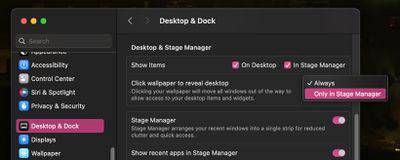
By default, macOS Sonoma hides all active windows when you click the desktop wallpaper. This is convenient if you tend to have a bunch of files on your desktop that you need to access. However, if you find this behavior maddening, there is a way to turn it off.

Apple’s latest macOS Sonoma Mac operating system has a new option called “Click the wallpaper to show the desktop.” Enabled by default, this option can be particularly useful if you tend to have multiple windows open and want to access files or folders on your desktop without having to minimize or move the windows.
After enabling this feature and clicking on the desktop wallpaper, all open windows will be temporarily swept aside, allowing direct access to the desktop. Once done, you can click again to return the window to its original position.
If you're unfamiliar with this behavior in macOS, it might be surprising when it first happens, but it can be especially annoying if you find yourself activating it over and over unintentionally. Fortunately, there is a way to prevent this from happening, but it requires you to first disable Presente Scheduling in the Control Center panel of the menu bar. Once you've done this, follow the steps below.

#That’s what it’s all about. As long as you disable front-end scheduling, clicking the desktop will no longer have any effect on the active window.
The above is the detailed content of How to disable the 'Click to Show Desktop' feature in macOS. For more information, please follow other related articles on the PHP Chinese website!
 Android desktop software recommendations
Android desktop software recommendations
 How to solve the problem of black screen after turning on the computer and unable to enter the desktop
How to solve the problem of black screen after turning on the computer and unable to enter the desktop
 Association rules apriori algorithm
Association rules apriori algorithm
 insert statement usage
insert statement usage
 What to do if the computer fakes death
What to do if the computer fakes death
 How to implement h5 to slide up and load the next page on the web side
How to implement h5 to slide up and load the next page on the web side
 Window function usage
Window function usage
 The difference between indexof and includes
The difference between indexof and includes
 How to solve the problem of 400 bad request when the web page displays
How to solve the problem of 400 bad request when the web page displays




